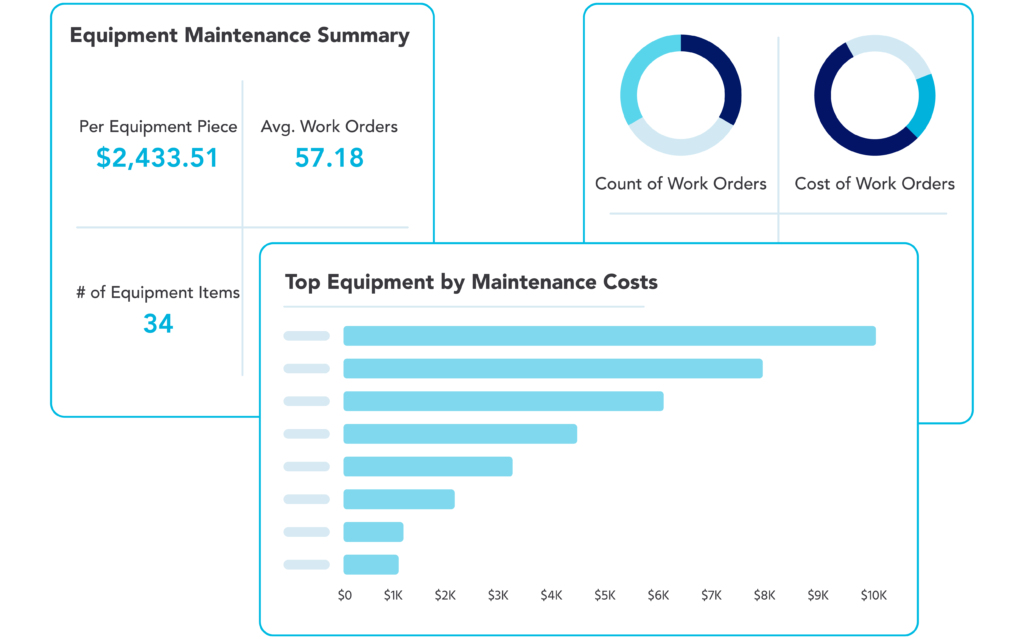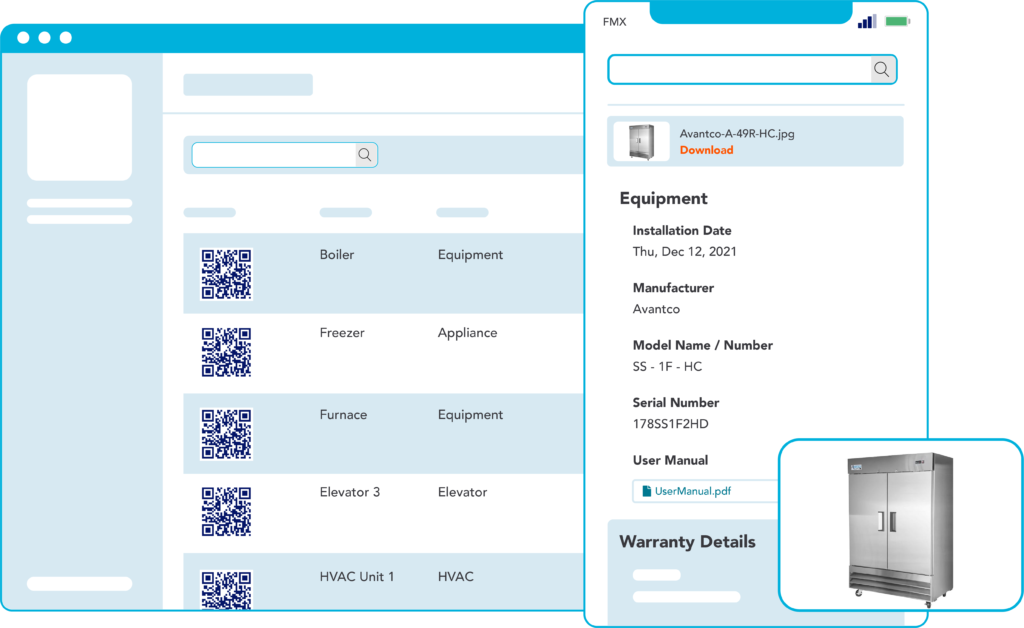Table of contents
- What is a facilities asset management system?
- Types of facilities asset management systems
- What are the benefits of a facilities asset management system?
- What are the key features of facility asset management systems?
- What types of industries use facility asset management systems, and what assets do they use them on?
- Summary
What is a facilities asset management system?
A facilities asset management information system is a powerful tool that centralizes data and provides financial insights on an organization’s assets. It simplifies resource planning by gathering all asset data into one place for easy review and analysis. To put it another way, the main goal of facility asset maintenance software is streamlining the collection, tracking, and storing of data on facility assets.
Types of facilities asset management systems
Some typical types of facility asset management software include:
Integrated workplace management system (IWMS)
An integrated workplace management system helps organizations optimize real estate and lease management, facilities and space management, asset and maintenance management, and project management. IWMS uses a single platform and database repository. Think of it as an inclusive one-stop shop for facility management, and particularly corporate facilities, with a secondary scope on assets. This integration of data can provide greater depth of insight, allowing you to create more informed asset maintenance plans and make better decisions.
Computer-aided facility management (CAFM) system
Computer-aided facility management focuses on physical workspaces, while also providing insight into maintenance and assets. It gives teams the ability to streamline their facilities’ operations by combining space management, maintenance management, data analysis, and engineering sciences. CAFM software is operable on multiple platforms and allows maintenance teams to plan for work that increases an asset’s lifespan and leads to less downtime.
Enterprise asset management (EAM)
Enterprise asset management systems focus solely on assets. It centers on asset life-cycle, beginning with the planning process and the scheduling of maintenance needs, all the way through to an asset’s demise and replacement. EAM offers an excellent means to understand an asset’s total actual cost and will streamline the process for keeping assets running.
Computerized maintenance management system (CMMS)
A computerized maintenance management system enables your organization to manage maintenance activities and, ultimately, increase asset productivity, decrease costs, and streamline processes.
The main goal of a facility asset maintenance system is to streamline all your data on facility assets.
What are the benefits of a facilities asset management system?
There are numerous benefits to using a facilities asset management system. A few of them include:
Reporting
A facility asset management system’s real-time reporting features can reveal everything from performance issues to opportunities for better preventive maintenance schedules. The ability to tailor reports means you can focus on specific requests from stakeholders and easily provide baseline metrics.
Financial impact analysis
Facility asset management systems can help organizations understand the financial impact that their assets have on their operations. This type of analysis helps define capital expenditures. It can also show you the cost of reactive maintenance and preventive maintenance plans.
Integration
The best facility asset management systems can integrate with other products; with that integration comes the capacity for operational optimization. When systems talk to one another, more data is shared, allowing you to create a clearer picture and greater efficiency.
Single source of truth
Facility asset management also provides a single source of truth. Having error-free data in one easily accessible interface removes the guesswork from planning and budget forecasting.
What are the key features of facility asset management systems?
When searching for a facility asset management system, there are some key features that you should look for in choosing a system. Facility asset management systems should contain:
Ability to track accurate asset financial data
This means that a facility asset management software system must track acquisition, asset depreciation, and lifecycle costs. Another item to look for is an inventory tracking system. Keeping tabs on inventory items can help track and curb excessive spending or budget drains.

Ability to track assets by multiple classes
Asset classes define an attribute of the asset. If a facility asset management system can only tag assets with one class, then your organization will not getting the whole picture.
The three minimum classes software should be able to track are:
- Type — defines what kind of asset an organization has. Is it a production-based machine? Office? Grounds? Type assigns the asset’s use.
- Location — defines where an asset lives. Knowing where an asset is can help speed up decision-making and deployment time. FMX has an interactive mapping feature that explains this process.
- Condition — defines the state an asset is in. Is it rusted and busted? Was it installed last month? Having an accurate picture of the condition of an asset can speed up the acquisition of necessary tools and help get the right crews in when a work order is issued.
Warranty management
Where is the warranty when you need it? A good facility asset management system keeps the warranty with the asset’s details; it can be easily recalled with the click of a mouse or finger swipe.
Mobile access
In today’s world, you need access to data when you need it, wherever you are. A functional facility asset management system must be accessible to a facility’s manager and maintenance team from a mobile device.

Minimal learning curve/short implementation time
Facility asset management systems should be easy to use and to understand, with a short implementation time for adopters. The sooner it is usable, the higher an organization’s return on investment (ROI) will be.
What types of industries use facility asset management systems, and what assets do they use them on?
So, who is using facility asset management software, and what kind of assets are being tracked?
Schools/institutions of higher learning
Schools often use asset management software to track equipment, technology items, buses and other fleets, and supplies.
See how Joplin Schools uses the software to track and report asset performance.
Industrial/manufacturing
In industry and manufacturing, use of a facility asset management system is almost second nature. From keeping line equipment up and running to making sure the software running it is updated, just about everything in a plant can be maintained by asset management.
Using asset management software, Ultradent, a global dental manufacturing company, can track over 1,000 pieces of equipment and implement a preventive maintenance plan for each of those assets.
Healthcare
The healthcare industry must follow stringent guidelines to maintain patient health and safety, sterilization practices, and operational goals for their assets.
Facility asset management systems help create equipment maintenance checklists and organize equipment—and for healthcare linen-only service provider, Faultless Linen, it keeps even the laundry hygienic and clean.
Restaurants & hospitality
Restaurants use facility asset management systems to maintain the grills, broilers, freezers, and other cooking equipment. Since tracking is extensive, owners and groups can easily verify the frequency and cost of repairs. They can also know when a particular asset is no longer cost-effective and needs to be replaced.
Primary Aim, a Wendy’s franchisee with 79 restaurants, does just that; it has saved them $33,000 on equipment costs.
Church/worship
Church and worship center assets are constantly in flux. It doesn’t help that church asset management processes are often older than the churches themselves! Facility asset management software can help your church institute cost-effective asset management processes.
For Christ the Redeemer Catholic Church, it was all about tracking asset work orders. They moved from a carbon copy paper system to a software that would give them the visibility and agility they needed.
Sports/gyms
Sports facilities and gyms often use facility asset management sytems to keep track of equipment locations and where equipment will be moving to next. Prolonging the life of training and game time assets can be accomplished using preventive maintenance features.
Entertainment
Whether a zoo, amusement park, or museum, entertainment facilities use facility asset management systems to maintain patron safety and improve the experience they offer. Cleaning, grounds maintenance, and making sure rides and people movers are in tip-top shape is an easy lift for asset management systems.
Read how the Polynesian Cultural Center (PCC) streamlined its processes and improved efficiency to realize an annual productivity savings of $450,000 with facility asset management software.
Read more success stories about facilities asset management software.
Summary
Facility asset management systems are helping organizations understand the financial impact that assets have on their operations—all while centralizing their data in one place. The single source of truth and reporting features this software provides allow for optimizing operations and saving costs.
Is facility asset management software right for your organization? Take FMX’s maintenance assessment and evaluate your facilities’ processes. Find out if you’re ready to take your asset management up a notch and improve visibility, budgeting, work order management, and more.
Written by
Dean Heid
Content Manager at FMX